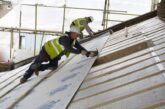
The Future Homes Standard (FHS) is expected to come into force this year, requiring new homes to produce 75-80% less operational carbon emissions than homes built under 2013 regulations. Insulation will be the critical enabler of this reduction.
Some details of the FHS are still subject to change under consultation, but many regulations have already had intermediate updates to provide a smoother transition. Housebuilders will need to understand what is likely to come into effect this year and how to ensure the real performance of new homes when installing insulation.

How have regulations already changed?
The Building Regulations have been updated in anticipation of the FHS. Approved Documents F (Ventilation) and L (Conservation of fuel and power) were updated in 2023, introducing new standards for ventilation, minimum energy efficiency performance targets for buildings, stricter airtightness requirements and tighter limiting U-values for new fabric elements.
New requirements such as the Building Regulations England Part L (BREL) report have also been incorporated into Standard Assessment Procedure (SAP) 10.3 to help verify the quality of insulation installations. One proposal under consultation is to replace SAP altogether with a new Home Energy Model to rate the energy efficiency of new homes and demonstrate compliance.
Enabling LZC
Low and zero carbon (LZC) technologies are a key part of the FHS, but the exact implementation of them is yet to be finalised. We can expect that they will form a part of all new home recipes.

LZC technologies depend on a well-insulated building envelope to be effective. Heat pumps, for example, come in a range of sizes and must be correctly matched to the space they’re heating. If more heat than designed is lost through the building envelope, it effectively increases the size of the space, making the heat pump less effective, even if the correct size was specified in the design.
Mechanical Ventilation with Heat Recovery (MVHR) systems also rely on airtight insulation to perform effectively. MVHR provides fresh filtered air into a building whilst retaining most of the energy that has already been used in heating the building.
Housebuilders should take a fabric first approach to provide flexibility on the adoption of LZC technology. An airtight and thermally efficient building fabric will deliver significant energy savings and improve comfort for building occupants, before any LZC technology is added. When the time is right to install this new technology, housebuilders or occupants can invest in them knowing that they will provide the maximum benefit.

Closing the performance gap
One of the industry’s biggest challenges in achieving the requirements of the FHS will be the ‘performance gap’ between how homes are designed to perform and how they perform once built. Current statutory guidance uses notional U-values to demonstrate compliance. Although U-values are an important indicator of thermal performance, achieving that performance relies on correct installation.
One proposed solution to this problem is to award a ‘Future Homes Standard’ brand to housebuilders who performance test their homes post-occupancy. Although this is still under consultation, it does show that the government wants to move the industry towards in-use data and the use of tools, such as Knauf Energy Solutions’ sensor technology, that measure in-use energy efficiency.

Housebuilders looking to close the performance gap will need to start scrutinising insulation’s performance in the context of the real world, particularly the installation experience.
Rigid board insulation, for example, can be particularly challenging as it won’t sit flush against a cavity unless it is perfectly uniform and flat. Boards also need to be precisely cut and taped, all of which can introduce air gaps that compromise thermal and fire safety performance. Mineral wool insulation, on the other hand, is flexible, conforms closely to the cavity, and knits together at joints, reducing the risk of air gaps and ensuring better overall performance.
Airtightness, ventilation and solar gain also need to be factored into the performance of the building to ensure homes meet the FHS.
The future is real performance
While some of the detail of the FHS is up in the air, it’s clear that housebuilders will need to start preparing for it now by prioritising the building fabric. Ensuring new homes perform as well in reality as they do on paper will substantially reduce in-use emissions and make the introduction of LZC technologies far more impactful on people’s bills and energy consumption.
To find out more about the FHS, including proposed notional home specifications, limiting U-values and guidance for Part L, visit Knauf Insulation Housebuilders Hub.







